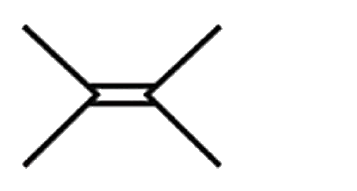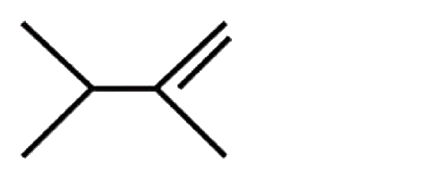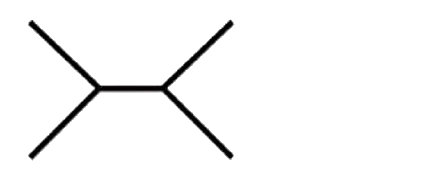Major product (A) is




The correct Answer is:B
To solve the problem of determining the major product (A) formed from the given reactant through an E1 mechanism, we will follow these steps:
Step 1: Identify the Reactant Structure
The reactant is a brominated alkane with the structure:
CH3|CH3−C−Br|CH∣CH3
This molecule has a bromine (Br) atom attached to a secondary carbon.
Step 2: Understand the E1 Mechanism
The E1 mechanism involves two main steps:
1. Formation of a carbocation.
2. Elimination of a beta hydrogen to form a double bond.
Step 3: Step 1 - Formation of Carbocation
In the first step, the bromine (Br) leaves, resulting in the formation of a carbocation. The structure after bromine leaves will be:
CH3∣∣CH3−C+∣∣CH∣CH3
Here, we have a secondary carbocation.
Step 4: Step 2 - Rearrangement of Carbocation
Since the secondary carbocation can rearrange to form a more stable tertiary carbocation, a methyl group from the adjacent carbon will shift to the carbocation carbon. The structure after rearrangement will be:
CH3∣∣CH3−C+∣∣CH3
This is now a tertiary carbocation.
Step 5: Elimination of Beta Hydrogen
Next, we need to remove a beta hydrogen to form the double bond. The beta hydrogens are the ones attached to the carbons adjacent to the carbocation. In this case, the beta hydrogens are on the carbons adjacent to the carbocation.
According to Zaitsev's rule (or Saytzeff's rule), the more substituted alkene will be the major product. Removing one of the beta hydrogens will lead to the formation of a double bond between the carbocation carbon and the adjacent carbon.
Step 6: Determine the Major Product
The major product will be a fully substituted alkene. The final product will have the following structure:
CH3|CH3−C=C|CH3
This represents a tetra-substituted alkene.
Final Answer
The major product (A) formed from the given reactant through the E1 mechanism is a tetra-substituted alkene.
---
The reactant is a brominated alkane with the structure:
CH3|CH3−C−Br|CH∣CH3
This molecule has a bromine (Br) atom attached to a secondary carbon.
The E1 mechanism involves two main steps:
1. Formation of a carbocation.
2. Elimination of a beta hydrogen to form a double bond.
In the first step, the bromine (Br) leaves, resulting in the formation of a carbocation. The structure after bromine leaves will be:
CH3∣∣CH3−C+∣∣CH∣CH3
Here, we have a secondary carbocation.
Since the secondary carbocation can rearrange to form a more stable tertiary carbocation, a methyl group from the adjacent carbon will shift to the carbocation carbon. The structure after rearrangement will be:
CH3∣∣CH3−C+∣∣CH3
This is now a tertiary carbocation.
Next, we need to remove a beta hydrogen to form the double bond. The beta hydrogens are the ones attached to the carbons adjacent to the carbocation. In this case, the beta hydrogens are on the carbons adjacent to the carbocation.
The major product will be a fully substituted alkene. The final product will have the following structure:
CH3|CH3−C=C|CH3
This represents a tetra-substituted alkene.
The major product (A) formed from the given reactant through the E1 mechanism is a tetra-substituted alkene.
Similar Questions
Knowledge Check
H3C−CH3∣C∣CH3−H+CCl4R2O2−−→hvProduct :
AH3C−CH3∣C∣CH3−ClBCHCl3CBoth (a) and (b)DNone of these
CH3−CH3∣C∣CH3−CH=CH−CH3H−Cl−−−→ ?
View Solution2CH3−CH3∣C∣CH3−CHO+NaOH→ The product is
View SolutionWhat is the major product alkene formed in the following elimination?
CH3CH2CH2CH3∣N+∣CH3−CH3∣C∣CH3−CH3Δ−−→
View SolutionThe conversation :
CH3−CH3∣C∣OH−CH3∣C∣OH−CH3dil−−−→H2SO4CH3−CH3∣C∣CH3−C∣∣O−CH3
is called :
View SolutionCH3−Br+NaO−CH3∣C∣CH3−CH3→ ?
The product is
View SolutionCH3−CH3∣C∣CH3−O−CH2−CH3Cold and conc.−−−−−−−−→HI?
The product is
View SolutionCH3−CH3∣CH∣CH3KmnO4−−−−→(A)H+−−→Δ(B)HBr−−−→ROOR(C)
Product (C) in the above reactions is :
View Solution
